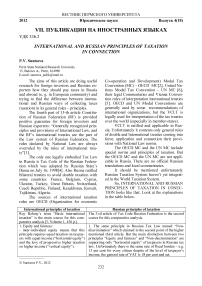International and Russian principles of taxation in connection
Автор: Suntseva P.V.
Журнал: Вестник Пермского университета. Юридические науки @jurvestnik-psu
Рубрика: Публикации на иностранных языках
Статья в выпуске: 4 (18), 2012 года.
Бесплатный доступ
Короткий адрес: https://sciup.org/147202208
IDR: 147202208 | УДК: 336.2
Текст статьи International and Russian principles of taxation in connection
The fourth part of 15-th article Constitution of Russian Federation (RF) is provided positive guarantee for foreign investors and Russian exporters: “Generally recognized principles and provisions of International Law, and the RF’s international treaties are the part of the Law system of Russian Federation. The rules declared by National Law are always overruled by the rules of international trea-ty”[1].
The only one legally embodied Tax Law in Russia is Tax Code of the Russian Federation which was adopted by Russian State’s Duma on July 16, 1998[4]. Also Russia ratified bilateral treaties to avoid double taxation with some countries: France, Belgium, Cyprus, Ukraine, Turkey, Great Britain, Switzerland, Czech Republic, Finland, Kazakhstan, Kuwait, Tajikistan, Algeria.
The sources of international taxation rules are OECD (Organization for economic
Co-operation and Development) Modal Tax Convention (MC) – OECD MC[2], United Nations Modal Tax Convention – UN MC [6], their legal Commentaries and Vienna Convention rules of interpretation international treaties [5]. OECD and UN Modal Conventions are generally used by some recommendations of international organizations, but the VCLT is legally used for interpretation of the tax treaties over the world (especially in member-states).
VCLT is ratified and applicable in Russia. Unfortunately it contents only general rules of double and International treaties coming into force, application and connection their provisions with National Law norms.
The OECD MC and the UN MC include special norms and principles of taxation. But the OECD MC and the UN MC are not applicable in Russia. There are no official Russian translations and local commentaries.
It should be mentioned unfortunately Russian Taxation System haven’t yet integrated in the World Taxation System.
So, INTERNATIONAL AND RUSSIAN PRINCIPLES OF TAXATION IN CONEC-TION looks like that. Look at the explanations in the table below.
|
International principles of taxation |
Russian principles of taxation |
|
Roy Rohaty’s issue “Basic international taxation” is the main source for this comparative analysis [3, Volume 1, 456 p.]. |
The 3-rd article of Tax Code Russian Federation is the second source for this comparative analysis. |
|
1. The same principle in Russian Tax Law named “Nondiscrimination” which claimed in the second point of the higher mentioned third article. But the main distinction between two principles “Equity and fairness” and “Non-discrimination” are supporting only “horizontal equity” of taxpayers in Russian tax law. Unfortunately there is the same rate of fiscal burden – e.g. 13 per cent for every citizen despite of the level of taxpayer’s income, the general rate of VAT is 18 per cent and ect. |
The Summary of the table:
International Tax Law is also called “compromise law”, because its subjects – mainly States (additional international organizations and international over-governmental, over-national structures) are equal and they should take into account each other interests.
In Russian National Tax Law system our state is only one powerful subject. The taxpayer is the weakest part of tax-paying relations. That’s why the provisions of Tax Code RF are mainly taxpayer’s wrights protecting (e. g. the presumption of taxpayer’s good faith, no retroactive effect of the proactive for taxpayer’s law). Because of the biggest territory in the world and a great number of fiscal needs (such as social support of Russian citizens, supporting of small national groups whose economies are not developed, great economic disproportion between developed and developing subjects of the RF) even keeping the same rate and the same number of taxes on the whole country’s territory is quite difficult task.
The bibliographic list
-
1. The Constitution of Russian Federation. 12, December 1993 // Russian paper. 2009. №7.
-
2. OECD Model Tax Convention: Introduction and Commentaries from Roy Rohaty . Basic international taxation. Second edition. Volume I: Principles. Published by: Richmond Law & Tax Ltd: 2005. P. 112– 142.
-
3. Roy Rohaty. Basic international taxation. Second edition. Volume I: Principles. Published by: Richmond Law & Tax Ltd: 2005. 456 p.
-
4. Tax Code of Russian Federation part 1was adopted by Russian State’s Duma on July 16, 1998 N 146-FL. Reduction from 26.11.2008. // Collection of Laws RF. 1998. №31. P. 3824.
-
5. Vienna Convention on the Law of Treaties (VCLT) was adopted on May 22, 1969 and entered into force on January 27, 1980. from Roy Rohaty . Basic international taxation. Second edition. Volume I: Principles. Published by: Richmond Law & Tax Ltd: 2005. P. 65–87.
-
6. UN Model Tax Convention: Introduction and Commentaries from Roy Rohaty . Basic international taxation. Second edition. Volume I: Principles. Published by: Richmond Law & Tax Ltd: 2005. P. 162–181.
Список литературы International and Russian principles of taxation in connection
- The Constitution of Russian Federation. 12, December 1993//Russian paper. 2009. №7.
- OECD Model Tax Convention: Introduction and Commentaries from Roy Rohaty. Basic international taxation. Second edition. Volume I: Principles. Published by: Richmond Law & Tax Ltd: 2005. P. 112-142.
- Roy Rohaty. Basic international taxation. Second edition. Volume I: Principles. Published by: Richmond Law & Tax Ltd: 2005. 456 p.
- Tax Code of Russian Federation part 1was adopted by Russian State’s Duma on July 16, 1998 N 146-FL. Reduction from 26.11.2008.//Collection of Laws RF. 1998. №31. P. 3824.
- Vienna Convention on the Law of Treaties (VCLT) was adopted on May 22, 1969 and entered into force on January 27, 1980. from Roy Rohaty. Basic international taxation. Second edition. Volume I: Principles. Published by: Richmond Law & Tax Ltd: 2005. P. 65-87.
- UN Model Tax Convention: Introduction and Commentaries from Roy Rohaty. Basic international taxation. Second edition. Volume I: Principles. Published by: Richmond Law & Tax Ltd: 2005. P. 162-181.


